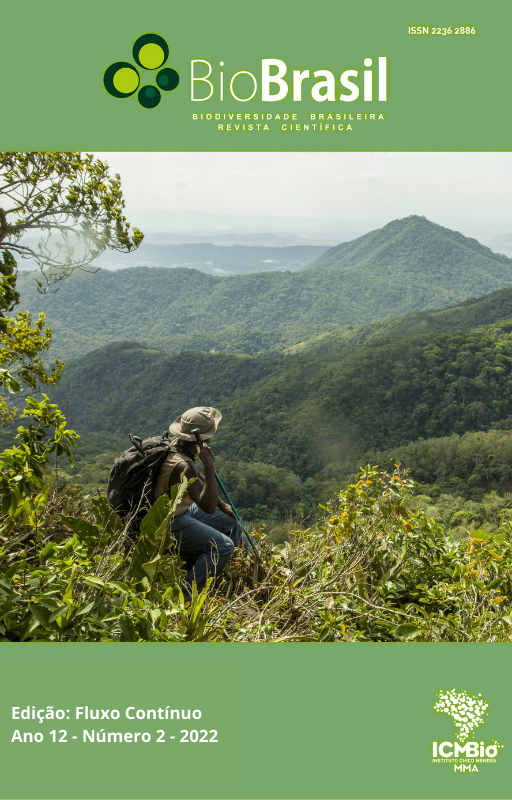Potential of Tree Species for Nesting by Native Bees (Apidae: Meliponina) in the Caatinga Biome
DOI:
https://doi.org/10.37002/biodiversidadebrasileira.v12i2.1786Keywords:
Biodiversity, conservation, pollinatorsAbstract
The Caatinga, an exclusively Brazilian biome which has a high level of endemism, has suffered from a biodiversity reduction due to the impacts of human activity, particularly those related to deforestation. As a consequence of that, the bee population has had its ecological niche impacted. Taking this into consideration, the present study aims to do an inventory of the tree species used for the nidification process of stingless bees in the Caatinga areas of the town of Paulistana, Piauí. In order to do that, periodical excursions were made from November 2017 to October 2018, in which botanical material of the trees used for nidification was collected, along with samples of the bee species that inhabited such nests. The results showed that the native bees’ nests were present in four tree species: Commiphora leptophloeos (Mart.) J.B Gillett, where most of the nests were observed (N = 67), Aspidosperma pyrifolium Mart. and Zucc., Cenostigma macrophylla Tul. and Spondias tuberosa Arruda. 72 native bees’ nests belonging to five different species were observed: Melipona mandacaia, Smith, 1863 (57 nests), Melipona marginata Lepeletier, 1836, with 7 nests, Frieseomelitta doederleini, Friese, 1900 (4 nests), Scaptotrigona tubiba, Smith, 1863 (1 nest) and Partamona seridoenses, Pedro e Camargo, 2003 (1 nest). The largest number of nests observed belonged to the Commiphora leptophloeos (Mart.) J.B Gillett, which suggests that this species is prefered for nidification by the stingless bees in the region studied – in particular by the Melipona mandacaia Smith, 1863.
References
Aguiar RB, Gomes JRC. 2004. Projeto cadastro de fontes de abastecimento por água subterrânea, estado do Piauí: diagnóstico do município de Picos. CPRM. 32p.
Barreto LS, Castro MS. Ecologia de nidificação de abelhas do gênero Partamona (Hymenoptera: Apidae) na caatinga, Milagres, Bahia. Biota Neotropica, 7(1): 87-92, 2007.
Batalha-Filho H, Waldschmidt AM, Alves RMO. Distribuição potencial da abelha sem ferrão endêmica da Caatinga, Melipona mandacaia (Hymenoptera, Apidae). Magistra, 2: 129-133, 2011.
Camargo JMF, Pedro SEM. Meliponini Lepeletier, 1836. In: Moure JS, Urban D, Melo GAR (orgs). Catalogue of Bees (Hymenoptera, Apoidea) in the Neotropical Region – online version, 2013. Available at http://www.moure.cria.org.br/catalogue. Accessed Sep/18/2021.
Cortopassi-Laurino M, Nogueira-Neto P. 2016. Abelhas sem ferrão do Brasil. 1ed. EDUSP. 124p.
Freitas BM. et al. Diversity, threats and conservation of native bees in the Neotropics. Apidologie, 40(3): 332-346, 2009.
Holzschuh A, Dudenhöffer JH, Tscharntke T. Landscapes with wild bee habitats enhance pollination, fruit set and yield of sweet cherry. Biological Conservation, 1(153), 101-107, 2012.
IBGE, Instituto Brasileiro de Geografia e Estatística. 2018. Produção Pecuária Municipal. https://sidra.ibge.gov.br/pesquisa/ppm/quadros/brasil/2018. Acesso em: 12/04/2019.
Khan AS et al. Desempenho da apicultura no estado do Ceará: competitividade, nível tecnológico e fatores condicionantes. Revista de Economia e Sociologia Rural, 47(3): 651-676, 2009.
Macedo CRC et al. Nesting behavior of stingless bees. Ciência Animal Brasileira, 21: e-58736, 2020.
Martins CF et al. Espécies arbóreas utilizadas para nidificação por abelhas sem ferrão na caatinga (Seridó, PB; João Câmara, RN). Biota Neotropica, 4(2): 1-8, 2004.
Mendes SS et al. Integrative approach untangles the misconceptions about the range and identity of two stingless bees from the Brazilian semiarid region. Apicultural Research, 59(4): 592-598, 2020.
Ollerton J, Winfree R, Tarrant S. How Many Flowering Plants are Pollinated by Animals? Oikos, 120(3): 321-326, 2011.
Orr MC et al. Global Patterns and Drivers of Bee Distribution. Current biology, 31(3): 451458, 2021.
Peixoto AL, Maia LC. Manual de Procedimentos para herbários. INCT – Herbário virtual para a Flora e os Fungos. Recife: Editora Universitária UFPE, 2013.
Silveira FA, Melo GAR, Almeida EAB. 2002. Abelhas Brasileiras, Sistemática e Identificação. Belo Horizonte, Fernando A. Silveira, 253p.
Ribeiro MF, Rodrigues F, Fernandes NS. A mandaçaia (Melipona mandacaia) e seus hábitos de nidificação na região de Petrolina (PE) – Juazeiro, BA. Mensagem doce. http://www.apacame.org.br/mensagemdoce/115/artigo2.htm. Acesso em: 17/10/2018.
Torres VS. 2012. Flora de importância apícola e meliponicola. 1ed. LP Books, 200p.
Venturieri GC, Raiol VFO, Pereira CAB 2003. Avaliação da introdução da criação racional de Melipona fasciculata (Apidae: Meliponina), entre os agricultores familiares de Bragança, PA, Brasil. Biota Neotropica, 3(2): 1-7, 2003.
Downloads
Published
Issue
Section
License
Copyright (c) 2022 Biodiversidade Brasileira - BioBrasil

This work is licensed under a Creative Commons Attribution-NonCommercial-NoDerivatives 4.0 International License.
Os artigos estão licenciados sob uma licença Creative Commons Atribuição-NãoComercial-SemDerivações 4.0 Internacional (CC BY-NC-ND 4.0). O acesso é livre e gratuito para download e leitura, ou seja, é permitido copiar e redistribuir o material em qualquer mídia ou formato.





 v3-3-0-3-2-1-8-release.27
v3-3-0-3-2-1-8-release.27